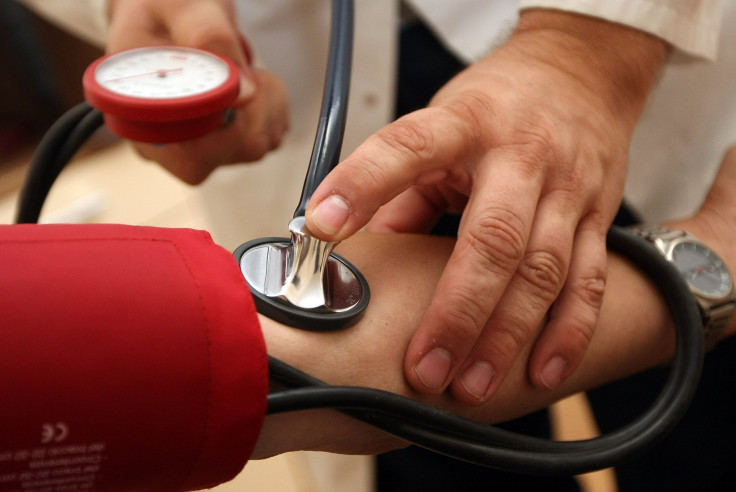Low Blood Pressure: Experts Think Even Lower Systolic Blood Pressure Better Prevents Heart Attacks And Heart Failure

If you've noticed a slew of heart health-related news, thus advice, in the past week — not just here but everywhere — it's because the American Heart Association (AHA) held its annual Scientific Sessions in Orlando, Fla. Several of the studies presented findings that could potentially improve patient care, preventing cardiovascular disease (CVD), and developing better diagnosis and treatment methods. One such prevention method is to maintain low systolic blood pressure (SBP). But just how low is up for debate.
First, what is SBP? It's the higher number you hear when your doctor reads aloud your measurements. SBP measures the pressure in blood vessels when your heart beats, while with diastolic blood pressure, the lower number you hear measures the pressure in your blood vessels when your heart is resting between those beats. Current guidelines recommend maintaining SBP at 140 or less — anything higher runs the risk of hypertension and CVD.
Two particular studies presented during the AHA's Scientific Sessions suggested lowering SBP target may be better for cardiovascular health. Both studies worked with data collected from the SBP Intervention Trial (SPRINT) — a trial that the government announced in September had ended two years ahead of schedule because their outcomes were so convincing. Only they failed to share what those outcomes were before the AHA's meeting. Now we know researchers have found proof a lower target SBP from 140 to 120 significantly reduces heart-related problems and death.
Researchers recruited 9,361 participants age 50 or older, who had an SBP between 130-180 mmHg (millimeter of mercury), are at high risk for CVD, and do not have diabetes or a history of stroke. They were assigned to receive either intensive treatment, which involved taking medications and adopting a healthier lifestyle to reach a target SBP of less than 120, or they were assigned to standard treatment, a target of less than 140 with similar lifestyle habits.
After one year, participants' average SBP was 121.4 mmHG in the intensive group and 136.2 in the standard treatment group. Participants had significantly lowered rates of fatal and non-fatal CVD events and death from any cause compared to those adhering to standard guidelines.
"SPRINT could have broad implications," says lead author Adam Bress, Pharm.D., M.S., assistant professor of pharmacotherapy at the University of Utah College of Pharmacy, said in a press release. "Millions of Americans whose blood pressure is under control according to current guidelines may be considered uncontrolled if new guidelines adopt the intensive target of less than 120 mmHg studied in SPRINT."
So in the second study, a separate group of researchers wanted to analyze SPRINT's preliminary results and try to "estimate the prevalence, number, and characteristics of U.S. adults" meeting this trial's same criteria using data from the National Health and Nutrition Examination Survey.
They found that more than 16.8 million Americans (7.6 percent) meet SPRINT's criteria. And this criteria was more prevalent among older Americans, males, as well as non-Hispanic whites compared to non-Hispanic blacks and Hispanics.
Notably, lowering SBP did have some side-effects: Some participants maintaining more intense goals experienced fainting episodes and kidney problems. But compared to the standard treatment, this was only about 1 to 2 percent higher.
"When we put those complications in the context of a 27 percent reduction in total mortality, it seems that the benefits outweigh the risks," said David M. Reboussin, a biostatistician at Wake Forest Baptist Medical Center and a principal investigator for the study, in an interview with The New York Times.
The Times added "it is now up to committees that formulate national guidelines to decide how to change their recommendations." As beneficial as lowering SBP target to 120 or less seemed to be, patients with diabetes were not included in this study and the same SBP target may not apply. The Times pointed out, too, researchers should advise both younger patients and older patients with no risk factors other than high BP.
Truth is, we could be years away from new guidelines, especially since not all experts agree with the present findings. For example, Dr. Michael Alderman, a blood pressure expert at Albert Einstein College of Medicine in the Bronx, told The Times that "the study results mean six people per 1,000 annually would avoid a heart attack, stroke, or heart failure, making it difficult to know how to advise individual patients."
"If there were no, or minimal, harms like a safe one-time vaccination, it would be a no-brainer," Dr. Alderman said. "But if it means decades-long pill taking by generally healthy folks, the decision gets more difficult."
Sources: The SPRINT Research Group. A Randomized Trial of Intensive versus Standard Blood-Pressure Control. New England Journal of Medicine. 2015.
Bress AP, et al. Generalizability of results from the Systolic Blood Pressure Intervention Trial (SPRINT) to the US adult population . Journal of the American College of Cardiology. 2015.



























